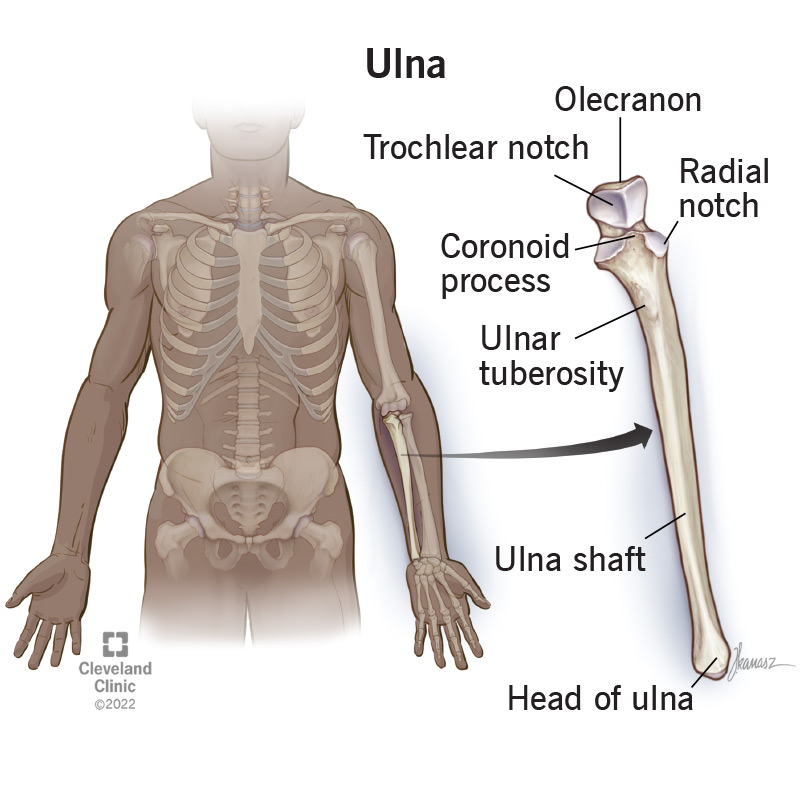The ulna is one of the bones in your forearm. It helps you move your arm, wrist and hand. If osteoporosis weakens your bones, you have an increased risk for fractures you might not even know about. Talk to a healthcare provider about a bone density test.
Advertisement
Cleveland Clinic is a non-profit academic medical center. Advertising on our site helps support our mission. We do not endorse non-Cleveland Clinic products or services. Policy

The ulna is the longer of the two bones in your forearm. It helps you move your arm, wrist and hand. Your ulna also supports lots of important muscles, tendons, ligaments and blood vessels.
Advertisement
Cleveland Clinic is a non-profit academic medical center. Advertising on our site helps support our mission. We do not endorse non-Cleveland Clinic products or services. Policy
If you experience a fractured (broken) ulna, you might need surgery to repair your bone and physical therapy to help you regain your strength and ability to move.
Your ulna — like all bones — can be affected by osteoporosis.
Because your ulna is connected to so many muscles and nerves, injuries to one can often affect the others.
Your ulna has several important jobs, including:
The ulna is one of two bones in your forearm. The other is your radius. The ulna is on the medial (pinkie) side of your forearm.
The ulna has a notched end where it meets your humerus (upper arm bone), a long shaft in the middle that’s slightly curved and a narrow end that meets your wrist. It’s slightly longer than the radius.
Even though it’s one long bone, your ulna is made up of several parts. These include:
The upper (proximal) end of your ulna connects to your humerus. It forms the bony point of your elbow. The ulna’s proximal end (aspect) contains the:
The shaft is the long middle portion of the ulna that supports the weight of your forearm and gives it its shape.
Advertisement
The lower (distal) end of your ulna forms part of your wrist joint. It ends in a rounded bump called the styloid process — the bump above your wrist on your pinkie side. The distal end is sometimes referred to as the head of your ulna.
Your healthcare provider may use all these parts and labels as they describe where you’re having pain or issues. If you ever break your ulna (an ulnar fracture), your provider might use some of these terms to describe where your bone was damaged.
The ulna is the second longest bone in your arm. It’s one of the longest bones in your body. Most adults’ ulna bones are around 11 inches (in.) long.
The most common issues that affect the ulna are fractures, osteoporosis and damage to the ulnar nerve. Common conditions include:
A bone fracture is the medical term for a broken bone. The most common causes of ulna fractures include:
Symptoms of a fracture include:
Go to the emergency room right away if you’ve experienced trauma or think you have a fracture.
Osteoporosis weakens bones, making them more susceptible to sudden and unexpected fractures. It usually doesn’t cause any symptoms you can notice, so many people don’t know they have osteoporosis until after it causes them to break a bone.
Females and adults older than 65 have an increased risk for developing osteoporosis. Talk to your provider about a bone density test that can catch osteoporosis before it causes a fracture.
The most common test done to check the health of your ulna is a bone density test. It’s sometimes called a DEXA or DXA scan. A bone density test uses low levels of X-rays to measure how strong your bones are. It’s a way for your provider to track bone loss as you age.
If you’ve experienced a humeral fracture, your provider or surgeon might need imaging tests, including:
Usually, your ulna won’t need treatment unless you’ve experienced a fracture or other injury to your arm. You might need treatment if you’ve been diagnosed with osteoporosis.
How your fracture is treated depends on which type it is and what caused it. You’ll need some form of immobilization like a splint or cast. You might need surgery to realign (set) your bone to its correct position so it can heal.
Advertisement
Treatments for osteoporosis can include exercise, vitamin and mineral supplements and medications.
Your provider will help you develop a treatment plan that’s customized for you and your bone health.
Following a good diet and exercise plan and seeing your healthcare provider for regular checkups will help you maintain your bone (and overall) health. If you’re older than 50 or have a family history of osteoporosis, talk to your provider about a bone density scan.
Follow these general safety tips to reduce your risk of an injury:
Your ulna and radius are the two bones that make up your forearm. They share the functions that let your arm and wrist move.
The ulna is slightly longer than the radius. It’s on the same side of your forearm as your pinkie fingers.
Advertisement
The radius is opposite the ulna and is on the thumb side of your wrist.
Both the radius and ulna are equally important pieces of your arm. They work together to support your forearm and wrist. Their shape and how they link together lets your wrist and hand rotate smoothly.
The ulna helps your arm, hand and wrist move smoothly. Usually, you’ll only need your ulna examined by a healthcare provider is if it’s injured. Talk to your provider about your osteoporosis risk, and ask them about ways you can support your bones as you age.
Advertisement
Cleveland Clinic’s primary care providers offer lifelong medical care. From sinus infections and high blood pressure to preventive screening, we’re here for you.

Last reviewed on 12/09/2022.
Learn more about the Health Library and our editorial process.